NEW ORLEANS BIOINNOVATION
CENTER STEPS UP ITS EFFORTS TO POSITION THE METRO AREA AS A DESTINATION FOR NEUROLOGICAL CARE P. 32

NEW ORLEANS BIOINNOVATION
CENTER STEPS UP ITS EFFORTS TO POSITION THE METRO AREA AS A DESTINATION FOR NEUROLOGICAL CARE P. 32







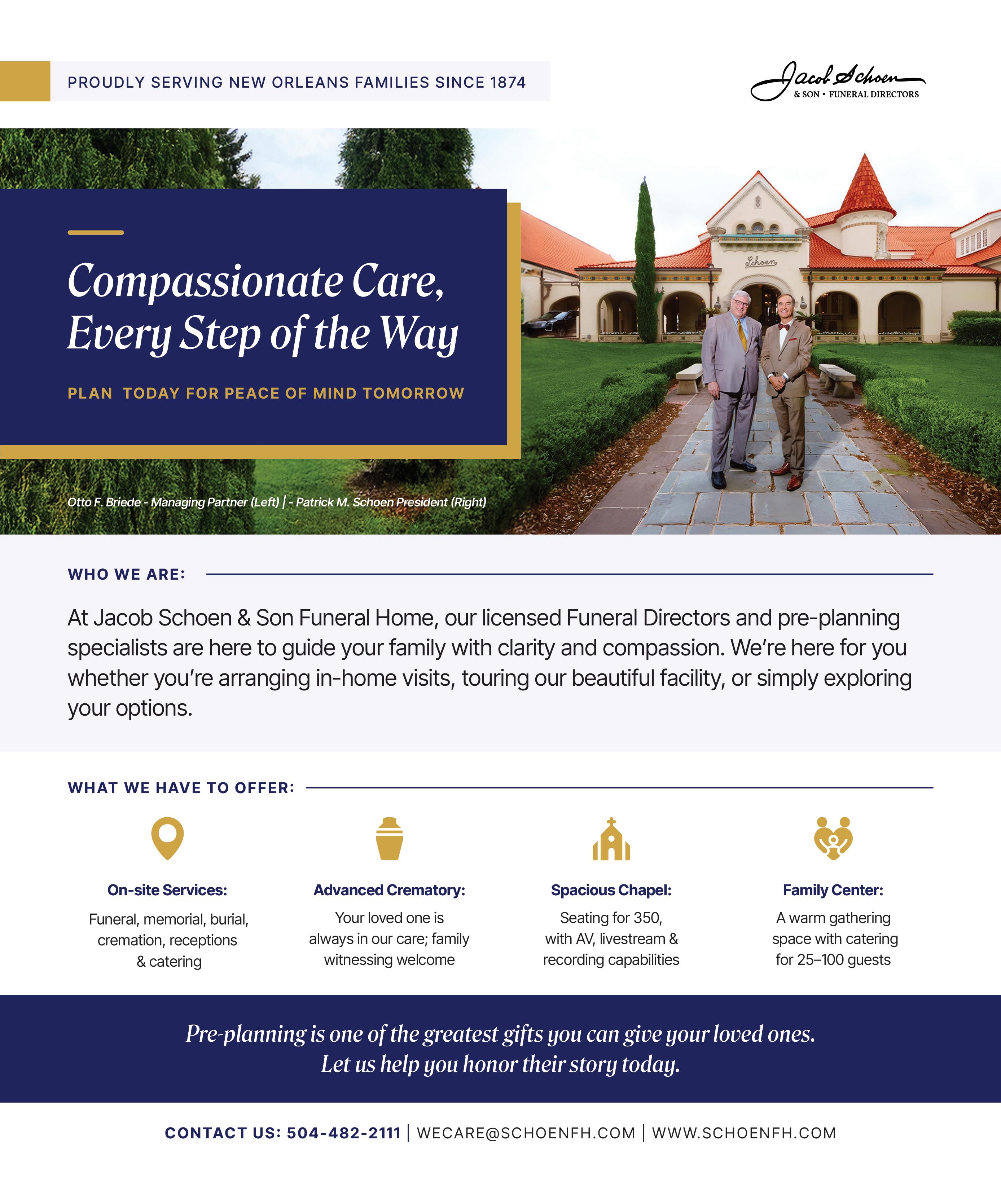





As UMC marks 10 years operating as one of the largest safety-net hospitals in the
hospital leaders share their thoughts on its successes and challenges
NOBIC steps up its efforts to position the metro area as a destination for neurological care

This is our first-ever healthcare focused issue, and it just happens to coincide with my own recent decision to make healthier choices.
One of the big ways I’m doing this is by limiting my alcohol intake — and I am certainly not alone in my quest to drink less.
I got my first taste, however, in how big the non-alcoholic beverage industry has become this past September when I attended New York City’s first zero-proof festival, Drinks With Benefits.
The vibe was much different from any New Orleans festival — for one, it was all indoors and there was no live music, just a very pregnant live D.J. There was, however, plenty to drink. More than 50 top non-alcoholic beverage companies from around the world were in attendance, including N/A beers and wines, drinks infused with adaptogens — natural substances that are designed to help with stress and mood — and THC/CBD beverages.
I had lots of great conversations, the most fascinating of which included a chat with a woman from France who shared that — even in a country known for its love of alcohol — 40 non-alcoholic shops are now operating in France; Paris launched its first N/A shop two years ago. I also spoke with the young owner of a company called Opius out of Belgium — which makes high-end elixirs using ancient recipes — about how Belgium is currently a leader in the booming N/A scene.
Festivals like this are popping up around the world with increasing frequency — from N/A

music festivals like the Coachella spinoff Soberchella in California to our own Bridge House/ Grace House’s Sober Fest, the fourth iteration of which will be held this month, Nov. 22, at The Broadside. There are also sober dating sites, travel companies, comedy nights, you name it.
The mood at the fest was one of youthful exuberance — like how you’d feel if you knew you were in the early days of something big. They are. Today’s young people are drinking less than any generation before them, and Gen X and Boomers are hitting ages where alcohol can cause more problems than it used to. This is all adding up to an N/A market estimated to be worth about $5 billion by 2028, with a compound annual growth rate for N/A spirits of 18% according to IWSR out of London — the leading global drinks data and insight provider.
Last month, the first N/A bar in Louisiana opened on Frenchmen Street above Bamboula’s — Mélange by Cali Sober Market. Will it be the first of many such businesses as New Orleans embraces more kinds of drinking? We shall see. Thanks for reading,

KIMBERLEY SINGLETARY Editor Kimberley@BizNewOrleans.com
Publisher Todd Matherne
Editor Kimberley Singletary
Art Director Sarah E.G. Majeste
Digital Media Editor Kelly Massicot
Associate News Editor Kelly Hite
Research Intern Alex Jorns
Contributors Dickson Griswold, Samantha Hindman, John R. Kerry, Walt Leger III, Ashley McLellan, Misty Milioto, Judy Reese
Morse, Chris Price, Gordon Hobson Rand, Keith Twitchell
Senior Account Executive
Meghan Schmitt 504- 830-7246
Meghan@BizNewOrleans.com
Account Executive
Abby Palopoli 504- 830-7208
Abby@BizNewOrleans.com
Account Executive
Caroline Benoit 504-830-7235
Caroline@BizNewOrleans.com
Digital Director Rosa Balaguer Arostegui
Senior Production Designer
Ashley Pemberton
Production Designer Czarlyn Ria Trinidad
Marketing Manager Haley Nash
Sponsored Content Coordinator
Jeremy Marshall
Visual Media Producer Mallary Wolfe
Distribution John Holzer
ADMINISTRATION
Office Manager Emily Ruiz
VP of Sales and Marketing Kate Henry
Chief Executive Officer Todd Matherne
For subscriptions, call (504) 830-7231



This month, we celebrate the release of the fifth edition of the New Orleans 500 — a look at the influential, involved and inspiring executives shaping the Greater New Orleans region.
Over the past five years, we’ve profiled nearly a thousand leaders across our 10-parish business community, and every one of them remains a valued member of the 500 Club. Here’s a little inside scoop — the list really totals 504! You can see the entire class of 2026 now at BizNewOrleans.com. As a subscriber, your personal copy will be arriving in the mail later this month.
Also happening this month is the Jefferson Chamber’s new event the IGNITE Summit, a young professional leadership summit taking place November 6, 2025, at the Jefferson Performing Arts Center on Airline Drive. For tickets and details, visit JeffersonChamber.org.
Congratulations to Greg Rusovich, recipient of the 2025 C. Alvin Bertel Award from the World Trade Center of New Orleans — a well-deserved honor for a longtime community and national leader. The annual luncheon and award presentation will be held November 7, 2025, at the Higgins Hotel. For tickets and more information, visit WTCNO.org.
A special salute to the Southeast Louisiana Council of the Boy Scouts of America. On November 11, 2025, The National WWII Museum’s Freedom Pavilion will host the organization’s annual Distinguished Citizen Award Gala, honoring this year’s recipient, Gov. Jeff Landry. Learn more at bsa-selacouncil.org.
As we enter the holidays and this season of gratitude, I’d like to say thank you to our readers, advertisers and staff for their daily dedication to delivering award-winning local coverage of our incredible business community.

CEO and Publisher Renaissance Publishing








16
Mark your calendars so you don’t miss any of the local holiday action
18
Want to put your business on a good path from day one? You need to make a call.
14 SPORTS
The start of the 2025 Saints sason is challenged by what ifs
The start of the 2025 Saints season is challenged by what ifs
BY CHRIS PRICE
There is a classic NFL Films Football Follies bit about games played in severe weather in open-air stadiums. As players endure the rain and mud, stumbling and fumbling, a voiceover that sounds like Porky Pig speaking on behalf of the players talks to God about the situations they face in less than ideal conditions. At one point, he struggles to say melancholy — “melancaca, melancaca, melancaca,” he stutters before saying, “We’re pretty darn sad.”
This bit reminds me of the 2025 New Orleans Saints and their fans. Going into the season, most knew it was going to be tough. Thirty-seven-year-old Kellen Moore took the reins as a first-time head coach. There was uncertainty under center, only a part-time quarterback had recorded a win as a starter, and questions on defense loomed.
As the draft approached, the thought was the Saints needed to pick players who could provide an immediate impact. The team made nine selections in the draft, headlined by firstround offensive tackle Kelvin Banks Jr. (No. 9 overall) and Tyler Shough (QB, 40th overall), as well as Vernon Broughton (DT, 71st overall), Jonas Sanker (S, 93rd overall), Danny Stutsman
(LB, 112th), Quincy Riley (CB, 131st), Devin Neal (RB, 184th), Moliki Matavao (TE, 248th), and Fadil Diggs (EDGE, 254th).
Unsurprisingly, Banks emerged as the starting left tackle, arguably the most important position on the offensive line. Broughton recorded three tackles before getting hurt and being placed on injured reserve. Sanker stepped into the starting free safety role and has made strong contributions. Stutsman is backing up defensive leader Demario Davis at left inside linebacker and done well. Riley has been a bit player as backup nickel back. Neal sits behind running backs Alvin Kamara and Kendre Miller and has seen limited action. Matavao has been a practice squad player, and Diggs was cut after Week 1 then re-signed for depth on special teams.
Sharp-eyed readers likely noticed Shough was not mentioned in the previous paragraph, and that’s part of why the “melancaca, melancaca, melancaca — we’re pretty darn sad” line echoes in my mind.
When training camp began, there was excitement that there would be competition for the starting quarterback position between Spencer Rattler – although he had yet to claim a victory — and Tyler Shough, the Saints’ highest-drafted QB since Archie Manning in 1971. Rattler won

the battle and has not lost his spot. Meanwhile, Shough has essentially gone missing in action.
Through the first five games of the season, Rattler, 25 years old, completed 119 of 177 pass attempts (67.2%), threw for 990 yards, six TDs, and one interception. The 26-year-old rookie had two passing attempts and no completions. While Rattler’s completion percentage is solid, he doesn’t often stretch the field with his passes and opposing defenses have noticed. He has averaged just 190.4 yards passing yards per game. With the rushing attack providing an average of 116.8 yards, the Saints were ranked 24th in the NFL in total offense with 307.2 yards per game, in early October. Worse, they averaged just 18.4 points per game, 28th in the NFL.
In the same time period, the Black and Gold defense gave up an average of 326.2 yards (204 passing and 122.2 rushing) and 27 points per game, both ranked 24th in the NFL.
That level of production gave the Saints just one win in their first five games.
The second reason the Porky Pig exclamation resonates is due to the success the New York Giants had in bringing in two rookies — QB Jaxson Dart (Round 1, Pick 25) and RB Cam Skattebo (Round 4, Pick 105) — both of whom the Saints could have selected. While neither player shone when the Saints beat the Giants in Week 5, there is no doubt that both have been impactful and have changed the trajectory of their season, if not their franchise. It begs the question: If both were in New Orleans, would things be better?
The final reason for being “melancaca” is the seemingly hopelessness shown by some Saints fans in the early part of the season. Crowds at the Superdome have appeared to be split 50/50 between home and away fans. The Saints are losing their “Domefield” advantage and making the gulf between the Drew Brees-led golden era and today evermore evident.
Hopefully, the second half of the season will be better for the Black and Gold. It’s too early to be forced to say, “Wait till next year!” T
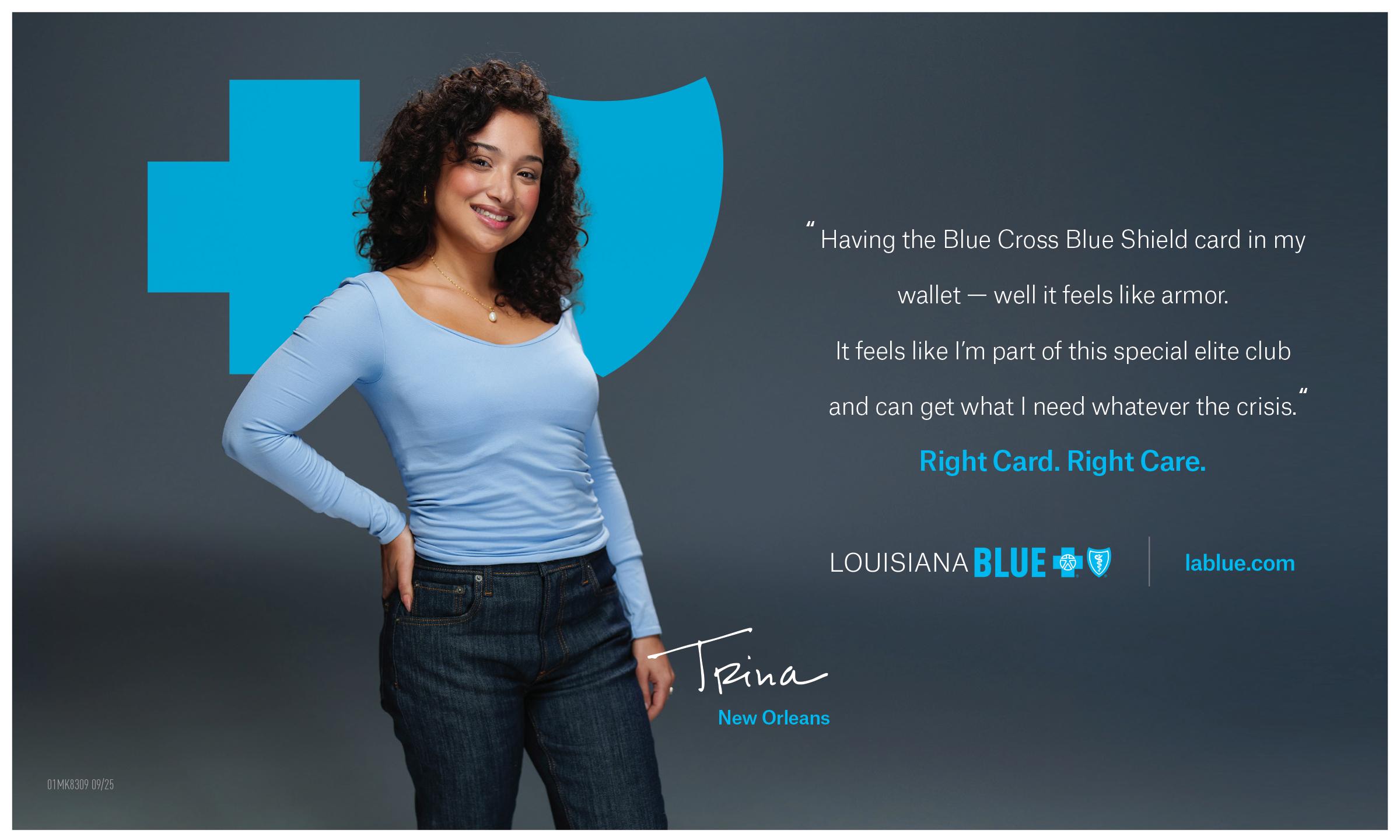


Mark your calendars so you don’t miss any of the action
BY WALT LEGER III
This year has been unlike any other. It started in tragedy with the horrific Bourbon Street attack on New Year’s morning. We continue to mourn the loss of life. In the aftermath of the attack, our city and residents stood strong and showed that no act of evil will deter us. We then pulled off a successful Allstate Sugar Bowl. A few weeks later, we experienced the biggest snowstorm in our history with a record 10 inches of snowfall, even as we welcomed one of our biggest customers,
WALT LEGER III is president and CEO of New Orleans & Company, the official destination marketing and sales organization for New Orleans tourism industry. He may be reached via email at walt@neworleans.com.
the National Automobile Dealers Association. Then came Super Bowl LIX, our 11th time hosting, where New Orleans was declared the real winner. All of this was then followed by an incredible Mardi Gras, spring festival season and many new events to drive summer business.
As 2025 comes to a close, let’s not forget how special the holiday season is in New Orleans. From Thanksgiving and Bayou Classic festivities to Christmas in the Oaks and Réveillon dinners, to celebrating New Year’s Eve, New Orleans provides countless opportunities to create memories.
A fall staple in New Orleans since 1974, the Bayou Classic in New Orleans between Southern University and Grambling University has turned into a weeklong celebration of two Historically Black Colleges and Universities (HBCUs) and an annual reunion for thousands of alumni and family.
The 52nd Annual Bayou Classic Football Game kicks off at 1p.m. on Saturday, November 29 at the Caesars Superdome. The Grambling “Marching Tigers” and the Southern “Human Jukebox” will again compete in a “Battle of the Bands” event held in the Superdome the night before the game.
While the game and Battle of the Bands are ticketed events, free events include a parade Downtown on Thanksgiving day that starts at the Caesars Superdome and proceeds down Poydras and Canal streets. There is also a Fan Festival at Champions Square prior to the game on Saturday starting at 9 a.m.
For the ultimate guide to Bayou Classic weekend, visit our website neworleans.com/events/ holidays-seasonal/ultimate-guide-to-bayou-classic.
Bayou Classic also leads into the holiday season, and there is no better place to celebrate the holidays than New Orleans.
What makes the holidays in New Orleans so unique? Whether it’s longstanding traditions like Réveillon dinners and Celebrations in the Oaks or newfound traditions like NOLA ChristmasFest, there is fun for all ages. Great weather mixed with countless activities make

New Orleans a must-visit destination for the holiday season.
Réveillon dinners, a New Orleans tradition dating back to the 19th century, continues at some of the best restaurants throughout the city starting December 1. For a list of participating restaurants and special menus, visit holiday.neworleans.com/food-and-drink/.
Tickets are available now for this year’s Nola ChristmasFest at the Ernest N. Morial Convention Center from December 20-29, and Celebration in the Oaks at City Park from November 28-January 1. Also mark your calendars for December 6, when the Manning Family Children’s Hospital New Orleans Holiday Parade will roll through the French Quarter and Downtown. And don’t forget about Caroling in Jackson Square on Sunday, December 21.
On our end, the New Orleans & Company team has been busy developing a similar marketing strategy to our summer COOLinary campaign by targeting the regional market, with ads being placed within a 150-mile drive radius — expanding the previous footprint that extended from New Orleans to Baton Rouge — as well as using incentivized hotel booking engines. We will also be sponsoring the New Year’s ball drop on New Year’s Eve.
January 1 will be an emotional day for many as we remember the lives lost from the Bourbon Street attack; however, we have the opportunity to show how far we have come by doing what we do best, host, as we welcome thousands of football fans from around the country for a College Football Playoff Sugar Bowl at the Caesars Superdome.
At New Orleans & Company, it’s our job to market our city’s world-class restaurants and attractions to visitors, but it’s also our job to ensure local participation as well. Our residents are what make New Orleans the most remarkable, unique and welcoming place in the world. We encourage everyone to take part in supporting our cultural economy throughout the holiday season.
For all things Holidays New Orleans Style, visit holiday.neworleans.com. T


supported and participated in entrepreneurial ventures at the street, neighborhood, nonprofit, micro- and macro-business levels.
Want to put your business on a good path from day one? You need to make a call.
BY KEITH TWITCHELL
When you’re starting a business the first thing on your mind is not likely to consult a lawyer, but according to David Rieveschl, a partner with the Stone Pigman law firm, it should be high on the top of a new entrepreneur’s to-do list.
“The sooner you contact a lawyer the better,” he said. “We can help put the right pieces in place for success early on and save time and money that would have been spent fixing things later that could have been avoided.”
Attorneys have a wide range of specialties, so finding a lawyer who focuses on business and entrepreneurism is vital. In addition to offering a free initial consultation to business owners, Stone Pigman, for example, partners with entities like the Tulane Innovation Institute and the Idea Village to conduct various entrepreneurial workshops and even puts together an “Entrepreneur Boot Camp.”
While there are many legalities entrepreneurs need to consider, depending on what stage their business is in, Rieveschl touched
on some of the essentials, beginning with the startup phase.
“You have to form some kind of legal entity,” he noted, “ideally with a liability shield.” Among the factors that determine the specific legal structure of a business include the number and type of partners, whether and when the company will seek to raise capital from investors, and whether employee compensation may include equity in the business.
If multiple founders are involved it is also important to execute appropriate founder agreements. Depending on the circumstances, these may cover expectations regarding investment of time and money, assigning of responsibilities and ownership percentages. The agreement should also address partner exit plans and processes and include non-compete agreements.
Critical in any entrepreneurial setting is managing intellectual property, which can include trademarks, copyrights, patents, software codes, business processes and even recipes – essentially any type of trade secret.
“Intellectual property can be a little tricky to quantify,” noted Rieveschl. “It’s not generally something you can hold and feel and touch.”
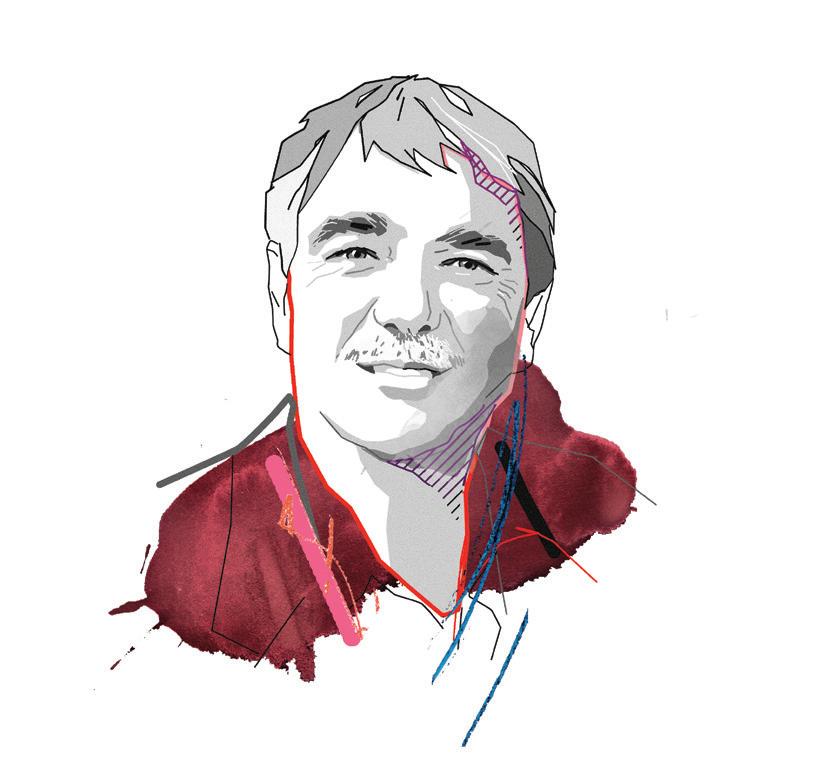
Intellectual property agreements should cover all staff and consultants, and sometimes even partners. Under Louisiana law, IP may by default belong to its creator unless otherwise arranged, so owners should be sure that all relevant agreements assign IP rights to their company, and that all other necessary protective measures are in place.
Employment and consultant contracts not only need to be very specific about issues of IP, confidentiality and non-competition, “they need to be tailored by time and geographic scope,” Rieveschl added, noting, “Some aspects of this are very narrow under Louisiana laws.” Contracts should also address issues including compensation, benefits and work location, i.e., in-office versus home.
Topping the list of frequent entrepreneurial headaches is obtaining licenses and permits. Attorneys can serve well here, as they are familiar with the processes and often have established contacts within government, enabling them to cut through a lot of the bureaucracy.
Another issue becoming more urgent every day is data security and privacy. Hackers are relentless and ruthless — Rieveschl reported that Stone Pigman itself experiences multiple hacking attacks almost daily. Addressing this potentially catastrophic problem from day one is critical, as everything from trade secrets to employee data can be at risk. As well, some industries have legal requirements to which companies must adhere to regarding protection measures and disclosure of breaches. Companies who fail to meet these requirements can be held liable.
One final issue to consider — too expansive to address in this space — relates to investor relations and agreements. Highly complex federal and state regulations, as well as founder and company priorities, all need to be considered.
“Entrepreneurship is one of the scariest and daring things you can do,” he said. “We all need to be investing in the entrepreneurial ecosystem.”T






22
BANKING + FINANCE
The Federal Reserve’s recent interest rate cut will have conflicting economic effects
26 MARITIME+PORTS
The effects of a Fifth Circuit Court ruling defining who can get overtime pay could ripple through the maritime industry 30 GUEST A local business strategist offers advice for entrepreneurs navigating uncertainty
Urban League of Louisiana is spearheading an initiative to generate an estimated $43 billion in economic output within the next 25 years
New Orleans is experiencing the largest wave of healthcare construction since the post-Katrina rebuilding era. Here’s what’s in the works right now.
DICKSON GRISWOLD is a senior wealth advisor and CERTIFIED FINANCIAL PLANNER™ with CAPTRUST. He may be reached via email at dickson.griswold@captrust.com.
The Federal Reserve’s recent interest rate cut will have conflicting economic effects
BY DICKSON GRISWOLD
The U.S. Federal Reserve System operates under a dual mandate: to support maximum employment and stable prices. Federal Reserve Chair Jerome Powell walks a tightrope of uncertainty, balancing tariffs and inflation while supporting the job market. On September 17, recent economic data — particularly a weaker-than-expected job creation report — triggered a 0.25% Fed rate cut. What will this mean for the U.S. economy, investors and consumers?
Lower interest rates tend to stimulate the economy by making borrowing less expensive. They make it cheaper for businesses to invest in new initiatives or to hire more employees. With consumer spending accounting for approximately 68% of U.S. GDP, lower rates could lower consumer borrowing costs — and thus increase spending.
The relationship between Fed credibility and market confidence should not be overlooked. While the Fed sets short-term rates, longerterm interest rates that affect mortgages and corporate borrowing are determined by the
reaction of bond market investors. This means Fed policy works best when investors are confident in the Fed’s ability to achieve its goals through both rate setting and guidance.
The 1970s are an example of a time when low confidence in the Fed drove up interest rates. By allowing inflation to sharply surge, the Fed lost credibility. Thus, bond market investors demanded higher yields to offset inflation risk— increased interest rates. In contrast, in the post2008 period during the great financial crisis, Fed credibility helped stabilize long-term inflation expectations. While the Fed was arguably slow to react to inflation after the COVID-19 pandemic, its swift rate hikes and strong statements helped restore lower inflation expectations.
From an investment perspective, declining interest rates can be positive or negative, depending on whether you are the lender or borrower. Lower interest rates mean that U.S. corporate borrowing is cheaper for the companies selling bonds (basically an IOU to the investor). At the same time, bond investors could see higher prices for the bonds they currently own but will receive lower payments from future bonds they purchase.

Today’s bond market environment suggests confidence remains strong. Credit yields and spreads have reached their lowest levels in years. But concerns remain that these valuations mean corporate bonds may offer limited additional return potential and could face challenges if conditions deteriorate.
While stocks are most affected by their company earnings and investor confidence, they are also impacted by interest rates. Despite a short-lived swoon in early 2025, economic strength, lower inflation and the expectations for lower interest rates have driven U.S. stock market indices to all-time highs. Conversely, at today’s price levels, the S&P 500 Index yields a relatively low 1.25%. When bond interest rates are falling, stocks — with their potential to provide both growth and income — may become more attractive to investors.
Consumers may expect that the Fed’s cutting of interest rates will lower the rate on mortgages. Unfortunately, this is not necessarily the case, as the Fed controls only short-term interest rates. Generally, mortgage rates tend to follow the 10-year U.S. Treasury yield — which is controlled by bond market trading. If mortgage rates decline meaningfully, we could see higher real estate prices and increased sales activity.
Unfortunately, those holding consumer debt should not expect their borrowing rates to sharply decline. While credit card rates may decline slightly, these reductions are historically slow and small.
The Fed’s decision to either raise or lower interest rates impacts the broad economy, U.S. businesses, and individuals in different and often conflicting ways — depending on if you are a lender or borrower, investor or consumer. Understanding how interest rates are set and how the bond market affects borrowing rates is important to your personal financial well-being. Seeking the counsel of an experienced banker or investment advisor is the first step to ensure that interest rate changes work for you. T


KELLY HITE is the associate news editor for Biz New Orleans, responsible for delivering daily business news on BizNewOrleans.com, focusing on developments that impact the greater New Orleans area and southeast Louisiana. She may be reached via email at KellyH@BizNewOrleans.com.

New Orleans is experiencing the largest wave of healthcare construction since the postKatrina rebuilding era. Here’s what’s in the works right now.
BY KELLY HITE
South Louisiana is seeing a surge of healthcare construction, with hospitals and universities investing hundreds of millions in new research labs, specialty clinics, children’s facilities and major campus redevelopments. The following are some notable projects currently in progress.
GAYLE AND TOM BENSON OCHSNER CHILDREN’S HOSPITAL This past April, Ochsner Health broke ground on the largest construction project in its history with the development of the $300 million Gayle and Tom Benson Ochsner Children’s Hospital on its Jefferson Highway campus. The hospital will span five stories and 343,000 square feet and is expected to open in early 2028.
Designed as a state-of-the-art, family-centered space, the facility will expand Ochsner’s pediatric capacity, which currently treats 100,000 children each year.
“We will be able to expand our critical care beds and operating suites, create a Level IV surgical NICU, increase our dedicated pediatric emergency department and create more collaborative, multidisciplinary spaces for our nationally recognized care teams,” said Dana Bledsoe, CEO of Ochsner Children’s Hospital. “All of this will lead to more care and better outcomes for pediatric patients in Louisiana and beyond.”

LSU HEALTH NEW ORLEANS MEDICAL EDUCATION BUILDING In the heart of Downtown, LSU Health New Orleans is leading the city’s biggest research laboratory renovation — a $109 million overhaul of the Medical Education Building (MEB), designed to modernize facilities and expand research capacity.
The $85 million construction effort, part of a $109 million total project budget, involves the complete renovation of three full floors and part of a fourth. Roof alterations and building-wide system upgrades will support new advanced equipment, while open-plan laboratory neighborhoods and reconfigured floor plans will make room for more principal investigator teams.
“This project will provide 150,000 square feet of state-of-the-art medical research laboratory space that will support our existing research teams as well as position the institution to recruit top-tier researchers from around the world,” said Dr. Steve Nelson, chancellor of LSU Health New Orleans. “In addition to serving as a learning environment for both research faculty and students, creating a cutting-edge laboratory space is a critical step on our pathway to achieving National Cancer Institute (NCI) designation, which will transform the developing medical district in New Orleans, stimulate economic growth for the city and state and provide world-class cancer care for the people of Louisiana and the Gulf South.”
After about 18 months of design work, Louisiana-based construction company Lemoine began work in late 2023 and expects to conclude the project in spring 2026. Nelson said that one of the greatest challenges has been carrying out extensive renovations in a facility that must remain in daily use.
“This project is particularly complex since the design called for fully demolishing the interiors of the three upper floors and adding two three-storyhigh glazed openings to two sides of the building,” he explained. “Additionally, this building houses the main large auditorium for the school of medicine, as well as offices and the cafeteria.”
Nelson emphasized that the existing laboratories were more than 50 years old and outdated. The modernization effort, he said, is
not only about supporting current faculty and students, but also about positioning LSU Health New Orleans for long-term growth and leadership in biomedical research.
OCHSNER MEDICAL COMPLEX – AIRLINE As work progresses on the new children’s hospital, Ochsner is preparing to break ground on another major investment: the Ochsner Medical Complex — Airline in Metairie, near Airline Drive and Tom Benson Way.
“The facility will serve as a hub for comprehensive health and wellness, empowering athletes and the community alike to achieve optimal performance and overall well-being,” explained Pete November, CEO of Ochsner Health.
The $45.6 million outpatient facility is slated to begin construction later this year and is expected to open in late 2027.
EXPANSIONS In September, North Oaks Health System completed its largest outpatient expansion to date with the opening of a five-story clinic building in Hammond. The $50 million, 95,809-square-foot facility, known as North Oaks Building 3, allowed the system to consolidate nine specialty clinics and 20 providers.
But the Hammond project is just the beginning. North Oaks has more than $160 million in additional investments planned over the next three years, including a new outpatient rehabilitation center set to open in early 2026. The facility will more than double the hospital’s current rehab space, positioning the North Oaks Health System to meet rising demand.
Plans also extend into education and workforce development. By 2030, North Oaks’ Graduate Medical Education (GME) program aims to train up to 48 residents annually in an effort to build a physician pipeline for the Northshore.
In partnership with Southeastern Louisiana University and Northshore Technical Community College, North Oaks is also backing major capital projects. At Northshore Technical Community College, a designated 15-acre site will house an 85,000-square-foot Health Sciences Center of Excellence, tripling student capacity and expanding to more than 25 programs of study.
At Southeastern, North Oaks is sponsoring a renovation and expansion of the Dugas Center and Strawberry Stadium to create the North Oaks Health System Academic and Athletic Complex, strengthening sports medicine, academic and athletic facilities alike.
“These partnerships are a powerful example of what can be achieved when local institutions come together with a shared commitment to education, health and community well-being,” said Michele Kidd Sutton, president and CEO of North Oaks
The [Ochsner Medical Campus] will serve as a hub for comprehensive health and wellness, empowering athletes and the community alike to achieve optimal performance and overall well-being.
Pete November, CEO of Ochsner Health
WALKER’S IMAGINARIUM Construction is well underway at Manning Family Children’s hospital on Walker’s Imaginarium, a two-story, 15,000-square-foot enrichment center designed to enhance pediatric care through play. The $16 million project broke ground in January, moved into full construction in February, and is on track for completion by the end of 2026.
Made possible through philanthropy, the Imaginarium reflects broad community investment in children’s health. The Imaginarium honors Walker Beery, founder of the nonprofit Kids Join the Fight, who lost his battle to pediatric brain cancer. Walker’s Imaginarium will include two floors of exhibits and activity spaces that include an immersive “Funky Forest” and “Percussion Tree” to a sports zone, a nine-hole “Putt Putt Parishes” mini golf course and a “Krewe of Walker Float” exhibit designed by Kern Studios.
“We have put together an expert project team to help bring the dream of Walker’s Imaginarium to life,” said Kristen Robinson, VP of marketing and institutional advancement at Manning Family Children’s.
Health System and a fellow of the American College of Healthcare Executives (FACHE). “They support workforce readiness while contributing to a healthier, more vibrant region.”
AND COVINGTON Tulane University is also advancing a series of major construction projects that will expand its research presence both downtown and on the Northshore.
At the Tulane School of Medicine, the Hutchinson Memorial Building is undergoing a $35 million renovation that will transform its seventh floor into modern laboratory space. The project will create capacity for about 20 additional principal investigators, with completion expected in 2025.
One of the city’s most ambitious redevelopment efforts also involves Tulane. The university has committed to occupy roughly 500,000 square feet in the former Charity Hospital at 1532 Tulane Avenue, where academic, research and innovation space will anchor a larger mixed-use program. Following New Orleans City Council approval in June 2025, the redevelopment team has moved forward with design, abatement and preparation work.
Beyond New Orleans, Tulane is expanding its facilities in Covington. The Tulane National Primate Research Center celebrated the opening of a 10,000-square-foot office building and a 1,000-square-foot biomedical laboratory in July, strengthening both administrative and research capacity at the site.
Designed by New Orleans-based EskewDumezRipple+, with exhibit design by California firm Gyroscope, the center is being fabricated locally by Solomon Group and built by Lemoine. A Seacrest Studios (a specially designed broadcast media studio) will also be part of the facility, made possible through the Ryan Seacrest Foundation and architecture firm HGA. “It was important to partner with local companies who are familiar with our campus, our Louisiana communities and have a proven track record of success,” said Robinson. “Gyroscope brings expertise in child enrichment and children’s museum spaces, previously serving as the exhibit design partner for the Louisiana Children’s Museum. Their passion and expertise have taken this vision and turned it into something far beyond what we had hoped for.”
LCMC EXPANSION PROJECTS ACROSS THE REGION
While Walker’s Imaginarium stands out as a centerpiece project at Manning Family Children’s, it is one of several major construction efforts moving forward across the LCMC Health system. University Medical Center is carrying out a $1.7 million cancer center expansion, New Orleans East Hospital is adding a $10 million behavioral health unit with 16 inpatient beds, and West Jefferson Medical Center is investing $3.2 million in a new MRI. East Jefferson General Hospital is also working on more than $50 million in upgrades, highlighted by a $22 million emergency department expansion and significant infrastructure improvements. T
The effects of a Fifth Circuit Court ruling defining who qualifies for overtime pay could ripple through the maritime industry
BY GORDON HOBSON RAND
There are currently approximately 125 active oil rigs currently operating in the Gulf. In the Greater New Orleans region, the oil and gas industry currently accounts for about 19,259 jobs with an average salary of $126,679. The energy sector employs a variety of workers, ranging from drillers and rig managers to accountants and attorneys — all of these are vital to Louisiana’s production of crude oil and natural gas.
When we think of lawsuits that affect oil and gas workers, we envision those that are triggered by disasters or workplace accidents. Costs can reach hundreds of millions or even billions of dollars.
There are a few ways oil and gas companies can manage risk and reduce litigation costs, such as adhering to safety improvements and following environmental protocols.
Another way to avoid litigation is to learn the rules of employee classification as it relates to overtime pay.
The United States Fifth Circuit Court of Appeals recently determined that two drilling specialists, who work 12-hour shifts for weeks at a time, did
not qualify for overtime compensation under the Fair Labor Standards Act (FLSA). The drilling specialists worked on location at well sites, monitoring the drilling operation to ensure safety and efficiency. At the end of their shift, the duo compiled and transferred oil well data.
The two drilling specialists sought overtime compensation from their oil and gas employer, which was denied. The employees responded by filing a lawsuit in federal court.
In general, the FLSA requires employers to provide overtime compensation to non-exempt employees working more than 40 hours per week. At first glance, these two specialists clearly qualify for overtime compensation. However, the FLSA carves out exceptions for employees working in a “bona fide executive, administrator, or professional capacity.”
The Fifth Circuit ruled that the two drilling specialists were highly compensated employees performing administrative duties and therefore excluded them from overtime pay. In doing so, the Fifth Circuit wrestled with a simple question whose answer affects all businesses in Louisiana, especially oil and gas. Who qualifies as an administrator?
Under the highly compensated employee exception, an employee classified as an administrator is exempt from overtime pay if

the employee meets all three of the following elements: (1) The employee is compensated $1,128 per week; (2) The employee regularly performs the duty of an administrator; and (3) The employee’s primary duty involves office or non-manual work.
Most people would likely assume that any labor related to oil well performance falls outside of administrative duties, especially when that labor is performed on site.
Section 541.200 of the FLSA provides a broad scope of administrative duties, including all “office or non-manual work directly related to the management or general business operations of the employer or employer’s customers.” Because the safety specialists’ primary duty was to monitor and transfer drilling performance data, the Fifth Circuit viewed the drilling specialists as advisors or consultants. In other words, they were classified as administrators. The ruling ignored the two specialists’ physical location, on an oil well, choosing instead to focus on the employees’ function within the drilling operation.
The ruling challenges traditional concepts of administrative work by expanding the scope of “office or non-manual work.” On its face, the two specialists have a strong argument for overtime compensation. They consistently work 12-hour shifts for weeks on end at the location of the oil well, which is normally offshore. Most office administrators work where their job title implies — at the office.
The Fifth Circuit’s broad interpretation of the FLSA may exempt new classes of employees who currently receive overtime benefits. Both employers and employees engaged in the offshore energy sector should be aware of the Fifth Circuit’s interpretation of FLSA to ensure they are complying with federal compensation schemes. For employers, a proactive approach to classifying employees can prevent needless and costly litigation. T



JUDY REESE MORSE is the president and CEO of Urban League of Louisiana. She may be reached via email at jmorse@urbanleaguela.org.
Urban League of Louisiana is spearheading an initiative to generate an estimated $43 billion in economic output within the next 25 years
BY JUDY REESE MORSE
At the Urban League of Louisiana, our mission is clear: to build a Louisiana where Black people and other communities of the global majority can achieve economic self-reliance, generational wealth, civil rights and equitable representation.
As a historic civil rights and direct service organization, we recognize that true empowerment is more than individual success; it is about transforming systems to create lasting opportunity.
What sets us apart is our ability to fuse programming with policy. We connect individuals with the tools they need to thrive today, while also advancing reforms that dismantle barriers to success in the future. This dual approach ensures that we are not only responding to immediate needs but also building pathways to sustainable change for generations to come.
We know that individuals have the creativity and drive to succeed, but too often face systems designed to limit opportunity. Our role is to
challenge those systems while creating tangible avenues for growth.
One of the most impactful avenues is entrepreneurship. We understand the rise of entrepreneurship as a pathway to economic independence and generational wealth creation, and we seek to support entrepreneurs across the state of Louisiana in gaining access to the education and support services needed to start and scale sustainable businesses.
One example of this is our flagship Scale Up! Louisiana program, a 10-week intensive for early-stage business owners that combines education, advising and networking to help small businesses transition into high-growth, sustainable ventures. Since 2018, the program has served nearly 200 entrepreneurs, with more than 60% reporting business growth or expansion. Designed around community needs, Scale Up! Louisiana integrates education, mentorship, funding and technical support so that entrepreneurs can build enterprises that last.
Another resource for entrepreneurs is our Connect to Capital Louisiana (C2CLA), an

eight-week program designed to strengthen entrepreneurs’ financial literacy and capital readiness. Participants gain financial education and learn to access funding sources such as SBA loans and equity investment. Participants also receive one-on-one counseling aimed at improving their financial management and readiness for growth. By combining business knowledge with access to capital, C2CLA ensures that more Louisiana entrepreneurs can compete and thrive.
Our most ambitious effort is the SEE CHANGE Collective, launched in 2021. This regional initiative is a data-driven effort designed to close the wealth gap and generate an estimated $43 billion in economic output by 2050. Closing the wealth gap is both a moral imperative and an economic necessity. By aligning government, business, philanthropy and community voices, SEE CHANGE addresses disparities facing Black, Hispanic, Latino, Asian and low-income families.
Currently, the SEE CHANGE Collective has more than 60 organizations committed to working together to close the wealth gap and strengthen the region’s economy with Urban League of Louisiana serving as the backbone.
The Collective’s action plan is driven by three working groups:
Homeownership: Tackling systemic barriers in the appraisal industry and expanding affordable housing. Early wins include a Certified Appraisers Pilot Program and support for the passage of the Housing Trust Fund.
Business Ownership and Entrepreneurship: Expanding access to capital and market opportunities for minority entrepreneurs. A new Minority-Owned Business Database and Dashboard help track progress and guide investment.
Wages and Income: Advancing equitable pay and career mobility. The Collective’s 2024 Good Jobs Report sets standards for inclusive workplaces.
At the Urban League of Louisiana, we are working on systems that serve the community and strengthen the economy, charting a new course for inclusive prosperity in Louisiana.T



JOHN R. KERRY is the author of Rise | Win | Lose, and the president, COO and business strategist at Xstrataflo, a business strategy and management consulting firm. He may be reached by calling (504) 444-9991 or by email at staff@xstrataflo.com

BY JOHN R. KERRY
In New Orleans, we are known for living with heart. Laissez les bons temps rouler — let the good times roll — is not just something we say during Mardi Gras or in the French Quarter. It speaks to our city’s enduring spirit, our ability to find joy and meaning even when circumstances are far from ideal.
Here in New Orleans, we experience our share of problems, probably more than most cities, but one thing that stands true is that we are resilient. But during hard times, especially when tourism is slow, foot traffic is scarce, and the city feels quiet in all the wrong ways, those words can start to feel a little distant. Letting the good times roll does not carry the same energy when your business is struggling to stay afloat and you are doing mental math at the end of each day just to keep the lights on. Even so, the deeper meaning behind that phrase still holds. It has never been about pretending that everything is fine. It has always been about bouncing back and thriving. In New Orleans, we have never relied solely on smooth conditions. We have built our lives and our businesses on creativity, community and the
ability to keep moving even when the odds are uneven. This is especially true for entrepreneurs, who must learn to navigate instability not just occasionally, but constantly.
Adaptability also plays a critical role, but it must be approached with intention. It is easy to fall into the trap of reacting to every shift and calling it agility. The most difficult and valuable skill is learning how to adjust without losing direction. Adjusting does not have to correlate with losing your identity. Often, I work with entrepreneurs to proactively prepare for times of difficulty as well as work with those who feel like they are falling behind simply because they are not changing fast enough. But movement without direction is not progress. It’s just hopes and dreams.
Entrepreneurship is not only a business journey but an emotional and psychological affair. As an entrepreneur, you are not only managing numbers and planning growth, but you are also managing fear, self-doubt, fatigue and the ongoing pressure to show strength even when you are unsure. In those moments, faith becomes essential. You must have faith in your preparation, faith in the values you built your business on, and faith that setbacks, no
matter how discouraging, are not the end of the story but part of your testimony. I understand that not everyone is a person of faith, but it is those Catholic virtues instilled in me that I live by that give me the strength to thrive each day and support entrepreneurs and small business owners in their pursuit of success.
Over the years, I have made decisions I would not make again and learned lessons I would not trade. One of the clearest truths that has come from those experiences is that the outcome of a business is never determined solely by external conditions. It is most often shaped by the mindset of the person leading it. I have seen businesses with every advantage fall apart because their leadership lost clarity. At the same time, I have seen business owners in far worse situations find steady ground simply because they stayed focused, kept showing up and trusted the process they had already committed to.
This becomes even more important in a city like New Orleans. When the usual flow of the city seems paused, the instinct for many businesses is to wait it out. But waiting without action is not a strategy. Instead, it is an opportunity to dig deeper, to reach out, and to get creative.
Success during slow times is still possible, but it rarely comes through isolation. It often comes through collaboration. We cannot elevate alone! Partnering with other local entrepreneurs, sharing resources, combining ideas and building community around shared values is not just good business, it is how the soul of New Orleans has always worked. We lift each other, especially when conditions are hard.
In New Orleans, thriving through uncertainty means leading with purpose, building with heart and staying rooted in creativity. Entrepreneurs who embrace innovation, authenticity and community can turn challenge into opportunity. Letting the good times roll means choosing resilience, creating momentum and standing for something greater than profit alone. Together, we all can win! T

New Orleans BioInnovation Center steps up its efforts to position the metro area as a destination for neurological care
PORTRAITS BY THERESA CASSAGNE

KKRIS KHALIL STARTS THE DAY not in a boardroom, but by balancing his attention between an 8-week-old commanding his attention and an 18-month-old toddler zig-zagging around the house.
Within hours, he'll trade that morning mayhem for a different kind of chaos: a New Orleans Chamber of Commerce event at the New Orleans BioInnovation Center, which will draw a few hundred business leaders for networking and discussion.
As executive director of NOBIC and managing director of the BioFund, Khalil is managing facilities, investments, and an ambitious vision to transform New Orleans into the nation's premier destination for brain care innovation.
That vision just took center stage on October 30, as NOBIC hosted BioChallenge 2025, a global pitch competition that was focused for the first time entirely on neuroscience innovations.
It's a bold bet on a massive market need and Louisiana's unique ability to address it.
NEW ORLEANS has no shortage of ambitious reinvention stories, but this latest push may be its boldest yet. According to the World Health Organization, neurological conditions have become the world's No. 1 health burden, affecting more than one in three people globally.
The economic toll is staggering: When accounting for unpaid care, lost earnings and quality of life the total national burden approaches a trillion dollars.


EVERY FALL, NOBIC puts the spotlight on innovation through its BioChallenge pitch competition, but this year’s edition will be devoted entirely to neuroscience and brain-health startups.
The event has already attracted more than 110 applications from around the world, covering everything from novel drug delivery mechanisms to digital therapeutics, neuromodulation devices, and small molecules designed to cross the blood-brain barrier.
On October 30, just after the BIO on the BAYOU conference — a two-day conference hosted at the Jung Hotel and NOBIC that showcases emerging biotech and health science breakthroughs — finalists will gather at NOBIC’s downtown facility to pitch their ideas before a room full of investors, judges and industry leaders. More than $100,000 in prizes is on the line, but the prize money is only a small part of the draw.
For Khalil and his team, the bigger goal is to make New Orleans “sticky” for these companies.
"What folks are looking for are clinical partners, pilots, research partners and investment, and so we're aligning all of those for the companies that we're going to be flying into New Orleans," Khalil explained.
FOR ALL THE MOMENTUM, Khalil is quick to acknowledge that building a biotech hub in Louisiana comes with its share of hurdles. Chief among them is the volatility of federal research funding. Programs like NIH grants or SBIR/STTR cycles have become less predict able,


leaving researchers and early-stage companies on edge.
Rather than wait for conditions to improve, NOBIC is actively building workarounds. The organization has hosted roundtables with Congressman Troy Carter and Sen. Bill Cassidy, convening stakeholders from academia, health systems, investors and policymakers to coordinate responses.
"While the community is, in a way, dealing with the uncertainty on the federal funding end, NOBIC is using this as an opportunity to convene the stakeholders and have conversations about what we can do to continue to build on this momentum that we have in New Orleans and Louisiana in the biotech space," said Khalil.
Another gap is talent. In more mature biotech hubs, startups benefit from “repeat operators,” founders who have built, scaled and sold companies multiple times. In New Orleans, where the life sciences industry is still relatively young, that bench is thinner.
To address the issue, NOBIC is cultivating a mentor network of seasoned biotech executives and actively recruiting companies back to the city. The return of Informuta and the relocation of Becken Bio from San Diego are case studies in how that strategy can work.
"There will always be bigger markets,” Khalil noted, “but our market competes very well on speed, connectivity and community.”
“
WHILE THE COMMUNITY IS, IN A WAY, DEALING WITH THE UNCERTAINTY ON THE FEDERAL FUNDING END, NOBIC IS USING THIS AS AN OPPORTUNITY TO CONVENE THE STAKEHOLDERS AND HAVE CONVERSATIONS ABOUT WHAT WE CAN DO TO CONTINUE TO BUILD ON THIS MOMENTUM THAT WE HAVE IN NEW ORLEANS AND LOUISIANA IN THE BIOTECH SPACE.
FOR KHALIL, this work is also quite personal. A New Orleans native who returned home after Hurricane Katrina, Khalil made the leap from banking to biotech in 2012 when he joined NOBIC to run the BioFund.
"It was a really unique opportunity to gain a new skill set and to help drive the post-Katrina economy in a frontier space," he noted.
After serving as executive director since 2018, Khalil sees the brain health initiative as something far beyond economic devel-
opment. His core goals involve extending productive lives and expanding what he calls "the longevity dividend."
"Folks who are able to live longer and live more productive lives for a longer amount of time naturally will help drive the economy even further," he noted.
“We’re very excited about the potential.”
But excitement alone won’t get the city there. Khalil emphasized that the next leap forward would require sustained collaboration and commitment. Universities, hospitals, investors and local government will need to rally around a shared agenda for brain health, developing policies that can support neuro-focused companies with the same urgency that other states are showing.
The good news is that the groundwork is already being laid. Thanks to NOBIC’s intervention and collaboration, local leaders are beginning to see brain care as both a healthcare issue and an economic growth strategy.
Khalil admitted his own awareness came late.
"Growing up here in New Orleans, I wasn't aware of the amazing infrastructure that we have here, the amazing amount of research that we have here, and the unique resources and the unique economy that we have in this space that we've had for over a century,” he said.
His goal now is to get others to see what he sees — that New Orleans offers the top-tier science, supportive community,and unmatched passion for innovation that brain startups need to thrive. T
AS UMC MARKS 10 YEARS OPERATING AS ONE OF THE LARGEST SAFETY-NET HOSPITALS IN THE COUNTRY, HOSPITAL LEADERS SHARE THEIR THOUGHTS ON ITS SUCCESSES AND CHALLENGES
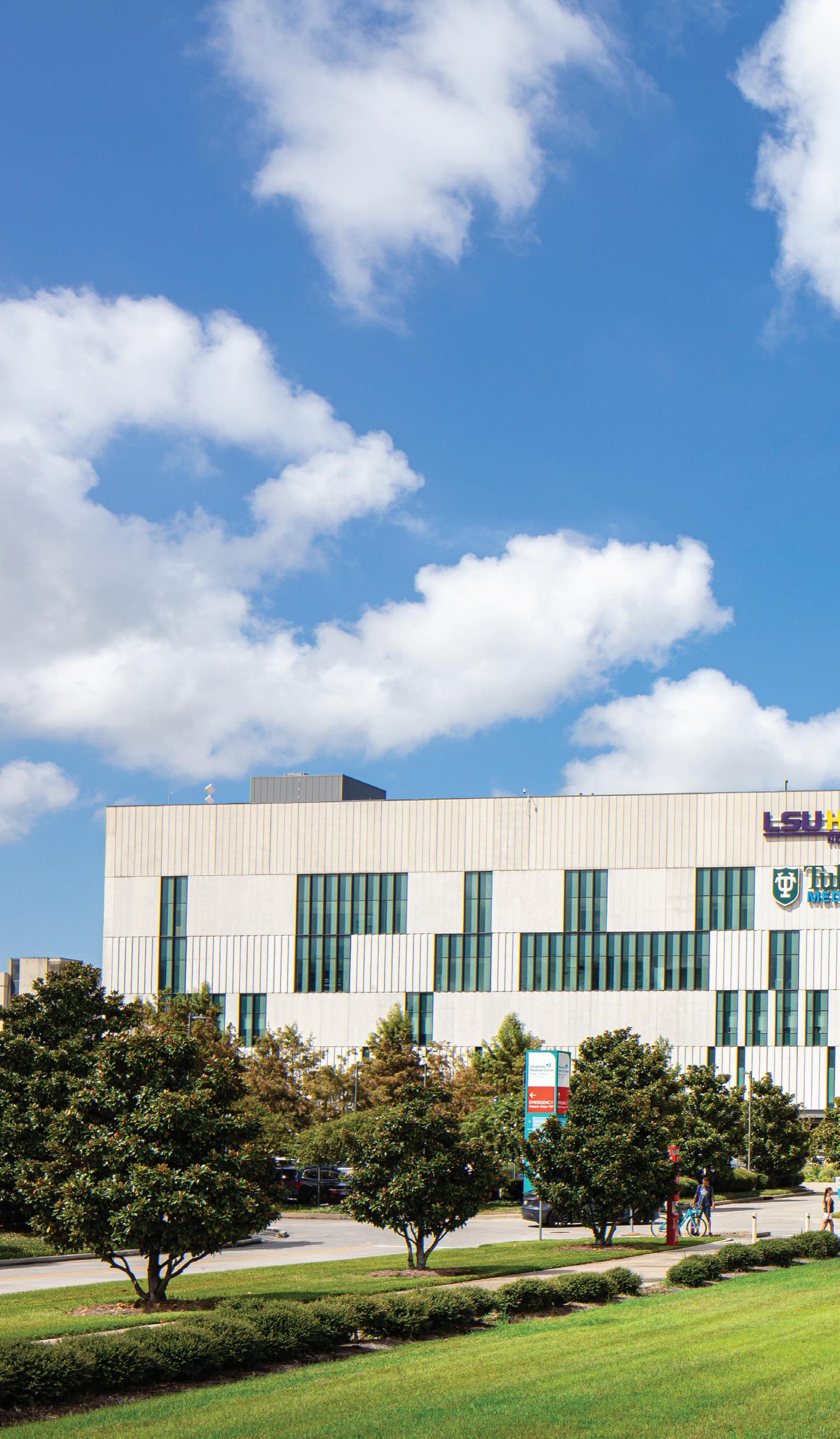
BY

FOR NEW ORLEANS LOCALS, the name Charity Hospital can stir up powerful emotions. So many were born or had been treated at the hospital, whose history of providing care for the area’s most economically disadvantaged reaches back to 1736, more than 40 years before the signing of the U.S. Constitution.
At the time, New Orleans was only a colony, and as it grew, so did the need for Charity’s services. Five versions later, so-called “Big Charity” opened on Tulane Avenue in 1939. With 2,680 beds, it was at the time the second-largest hospital in the United States.
After Hurricane Katrina decimated the hospital in 2005, what to do with the building’s hulking shell became a subject of considerable controversy. The building is still vacant, but 10 years
to the month later, on Aug. 1, 2015, a modern, $1.1 billion hospital finally took over Charity’s mission — University Medical Center (UMC).
As it celebrates its 10th anniversary this year, UMC stands as one of the largest safety-net medical facilities in the United States. Its 37-acre Downtown campus, occupying several blocks between Canal Street and Tulane Avenue, bisected by South Galvez Street, centers around the three patient towers, which collectively encompass 2.3 million square feet. There are 446 total patient beds, with occupancy typically reaching 90%.
The hospital’s focus on emergency care is evident: In addition to a rooftop helicopter pad, UMC boasts 56 emergency exam rooms, nine acute treatment rooms and five trauma rooms.

Nineteen operating rooms are supported by dozens of pre- and post-operating rooms.
Unsurprisingly, its size and scope make UMC a significant economic driver. The hospital employs about 2,500 people (LCMC employs upward of 18,000 people) and its roughly $1 billion annual budget generates an estimated $600 million a year for New Orleans and the surrounding region.



KTOM PATRIAS, CHIEF EXECUTIVE OFFICER OF UNIVERSITY MEDICAL CENTER NEW ORLEANS GREG FERIN CHIEF EXECUTIVE OFFICER OF LCMC HEALTH
In 2015, with New Orleans still in post-Katrina recovery mode, and with both physicians and treatment centers scattered around the city, UMC had to hit the ground running.
“Health care in New Orleans was pretty awful at that point,” recalled Dr. Peter DeBlieux, who served as chief medical officer when UMC opened, “and UMC was built to remedy this. We went from underfunded to this $1.1 billion Taj Mahal.”
The lessons of Katrina heavily informed the design and construction of the new building. For instance, the layout was created in partnership with the medical personnel with the goal of maximizing efficiency and making patient access as easy as possible.
“We were able to reestablish health care in a fashion that advances it forward by decades,” said DeBlieux.
UMC was, unsurprisingly, also built to withstand hurricanes — specifically strong Category 3 hurricane winds — and has triple redundancy for its power sources. All critical patient and treatment areas are located at least 20 feet above base flood elevation.
“It’s the safest hospital in the region,” noted DeBlieux. “We’ve never had an interruption in service since it opened.”
Construction of the facility was undertaken by the state of Louisiana, which still owns the buildings. LCMC — a regional eight-hospital system — leases and operates the hospital, a public-private partnership that is unusual in the health care field but that Greg Feirn, CEO of LCMC Health Systems, noted is essential to UMC’s ability to provide its services.
“As a safety net facility, funding can be a challenge,” he said. “We’ve always had as part of our mission to care for all regardless of their ability to pay. Our partnership with the state has allowed us to do that.”
Feirn added that UMC’s existence within the larger LCMC network also contributes to the hospital’s capacity to keep its doors open to all. DeBlieux noted that Louisiana’s expansion of Medicaid benefited both the facility’s finances and its patients, noting that many area residents are one accident away from substantial financial difficulties.
Two other partners are vital to the operation of UMC — the LSU Health System and the Tulane University School of Medicine.
“UMC provides a platform to teach medical students and allied health care professionals like nurses and clinicians,” explained DeBlieux, who added that the majority of those who are trained at the facility stay within the community.
“We grow their faculties, recruit them to New Orleans,” concurred Feirn, “while training future New Orleans health care providers.”
Six additional local institutions of higher education are also engaged in teaching and research at UMC: Delgado Community College, Dillard University, University of Holy Cross, Loyola University, Southern University and Xavier University.
Just in time for its 10th anniversary, UMC appointed a new president and CEO: Tom Patrias, who took the helm this past July after serving 18 months as the hospital’s chief operating officer. Previously the CEO of Tulane Medical Center, Patrias brings leadership experience and knowledge of the landscape and players to his new role. He listed several aspects that make UMC so unique and valuable to its Gulf South patient base, including that UMC is the only Level One trauma center in the region, is home to the only verified burn center between Tampa, Florida, and Galveston, Texasm and provides behavioral health care with 60 beds and 85% of the market share.
DeBlieux also cited the importance of the hospital’s palliative medicine clinic, one of the first in the region. In addition to end-of-life care, the clinic also specializes in chronic disease medicine.
“We provide dialysis, treatment for chronic lung and heart disease and people living with cancer,” he elaborated. “We do a lot of symptom management. We want to treat people before they reach extreme sickness.”
In addition to a wide array of specialties, UMC offers a wide range of more routine types of medical care, including allergy and respiratory care; plastic and reconstructive surgery; women’s health care, including mammograms and breast imaging; infectious disease treatment; and heart, vascular and stroke care. Virtual health care is also available.
UMC is formally accredited in a variety of medical fields. In addition to the Level One Trauma Center and the Burn Center, these include

weight loss and bariatric surgery; the Advanced Primary Stroke Center designation; the Cancer Center; and recognition as an Antimicrobial Stewardship Center of Excellence by the Infectious Diseases Society of America (IDSA).
Additional facilities and programs round out the picture. A triennial community health needs assessment, conducted with multiple other medical facilities and community organizations, helps identify and align priorities with regional health requirements. The eight-room conference center hosts professional groups, corporate events and community meetings. UMC’s designation as an Academic Medical Center highlights its teaching and research emphasis, including specialties as diverse as pharmacy and dentistry alongside its more regular treatment areas.
The benefits of all these specialties to a region like Greater New Orleans and the Gulf South are clear cut. From industrial accidents to gunshot wounds, high rates of diseases such as diabetes to the vestiges of poverty and broken families, the area has a higher-than-average need for widespread access to health care.
The specialty clinics and services also enhance the teaching and research aspects of UMC. The burn center, for example, is considered a world leader for research in its field, and emergency care physicians all over the country count UMC, and Charity before it, as vital to their training.
Patrias noted that several events over the past year particularly tested the trauma center: including the massive vehicle wreck on Interstate 55, and the terrorist attack on Bourbon Street in the early morning hours of New Year’s Day 2025.


DR. PETER DEBLIEUX SERVED AS CHIEF MEDICAL OFFICER WHEN UMC OPENED


union leadership. We will continue to negotiate in good faith.”
Feirn echoed that point.
“We’ve never paused the negotiations, and we continue to work toward getting a contract,” he said. “Providing health care is a team effort, and the nurses are part of that team.”
Despite this enormous presence, it is not entirely clear that everyone knows of the existence and role of UMC as that health care safety net.
“It’s a challenge making sure that the community understands that we are here for them,” explained DeBlieux, noting that the entity changing names after almost 300 years of being Charity Hospital contributed to the confusion.
DeBlieux feels that the situation has improved over the hospital’s decade of service, overcoming much of that initial doubt. “The community asked, ‘Will we be welcome inside that $1.1 billion facility?’ and UMC unequivocally said ‘Yes!’”
One ongoing method UMC uses to address this is by emphasizing “The Spirit of Charity” in much of its messaging. This includes highlighting staff members whose service goes well back into the Charity Hospital era – and even several who are “Charity babies,” born at the old institution as were so many famous New Orleanians.
L“When the call [on New Year’s Day] came in to all members of the administration and all members of the trauma team showed up despite it being a holiday,” he recounted. “Even people who weren’t on call, medical staff and administration, came in wanting to know what they could do to help.
“Whenever there’s an event, we’re showing up for the community,” he continued. “People come to work at UMC to work for the community.”
A different kind of challenge has confronted the administration over recent months: a difficult set of talks with the nurses’ union on a new contract.
“The negotiations remain active,” Patrias said, indicating that he was hoping for a rapid resolution. “We meet two times per month with the
The tenth anniversary provides another opportunity to drive home that message, as well as to take stock and look to the future.
“The anniversary is a recommitment to innovation and growth, to equitable access and reducing barriers to health care,” said Patrias. “We will continue to expand access and our quality of care. We will continue to enhance our infrastructure and capacity to serve more patients. We will continue to grow our research, and enter into new, cutting-edge medical fields.”
“We look forward to seeing the growth, not just in patient care but in research, innovation and training the next generation of health care professionals,” agreed Feirn. “We will continue to invest in the community.”
Underlying all of this is the awareness of, and commitment to, being that vital safety net for all those seeking health care.
“Our guarantee to New Orleans and the region is that our door is always going to be open,” affirmed Patrias, “to provide the care that is required, regardless of the patient’s circumstances or the circumstances that got them here.”
“This is and always will be a hospital that will provide care for all,” concluded DeBlieux. “There will always be a continued commitment to the spirit of Charity.”
2015 - University Medical Center New Orleans opened August 1, safely relocating 131 patients from Interim LSU Hospital to the new, state-ofthe-art medical facility.
2021 - The Burn Center received American Burn Association verification, the Outpatient Surgery Center opened, and construction began on second parking garage. The new 1,365-space parking garage opened for hospital staff and the outpatient Behavioral Health Center opened at 2475 Canal St.
2022 - University Medical Center earns national accreditation as a Comprehensive Center for Bariatric Surgery and receives Geriatric Emergency Department accreditation.
2023 - University Medical Center received Magnet Recognition from the American Nurses Credentialing Center (AANC). This prestigious designation distinguishes organizations that meet rigorous standards for nursing excellence.
2024 - Launch of Healthy Brain Aging Initiative, a program designed to address cognitive health in aging patients across three LCMC Health centers. T

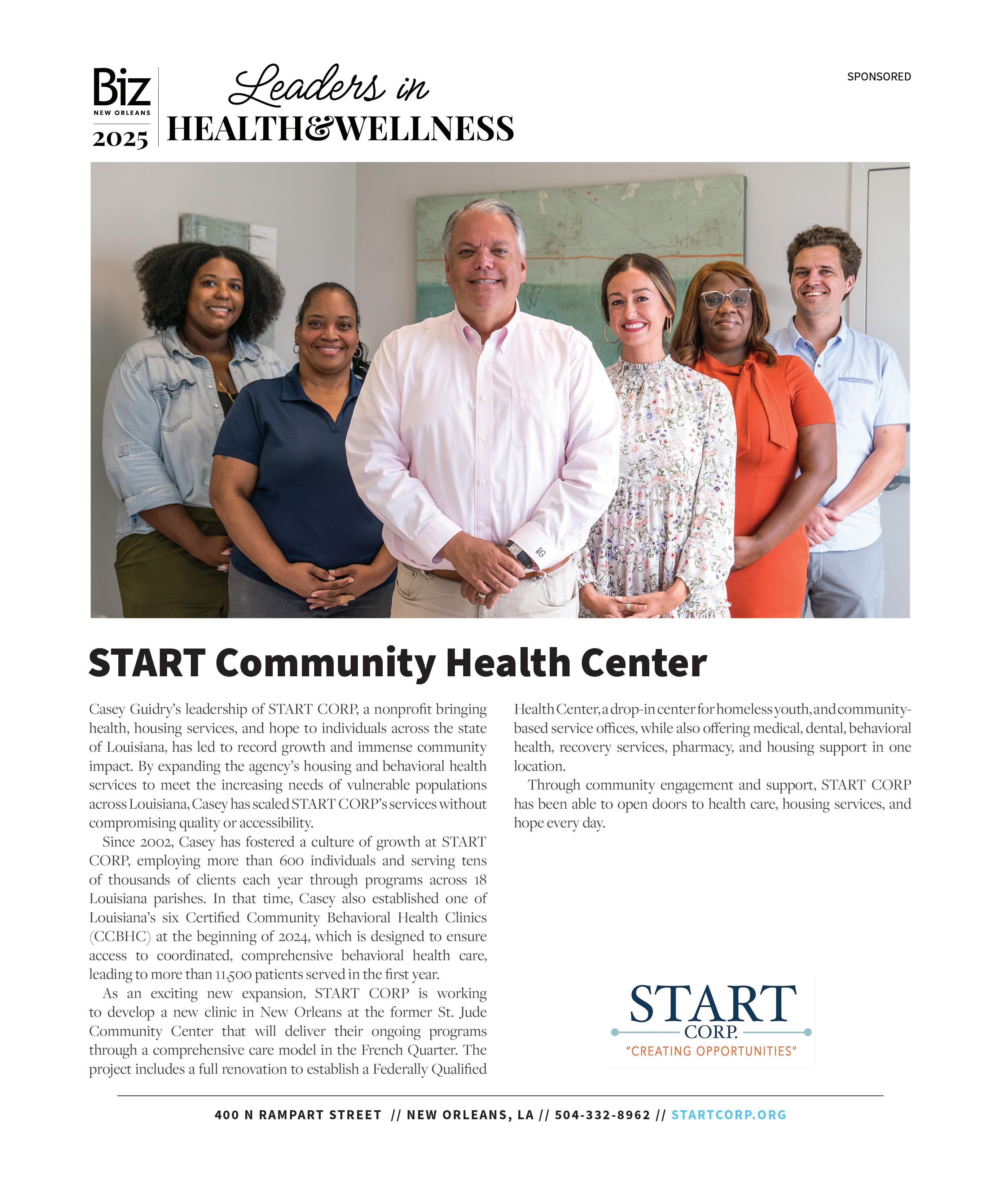












58 WHY DIDN’T I THINK OF THAT?
A unique women’s fitness club in Metairie is offering the flexibility, community and results women want.
FROM THE LENS
GREAT WORKSPACES
The Plant Gallery gets a modern office transformation in Metairie.
BY MISTY MILIOTO
PHOTOS BY SARA ESSEX BRADLEY
After three decades of cultivating beauty across New Orleans through landscaping and floral design, The Plant Gallery has taken root in a thoughtfully reimagined office space that reflects both its creative mission and operational needs.
The company’s new 68,000square-foot headquarters in Metairie represents more than just a change of address — it’s a complete transformation of how a multifaceted business can work and inspire all under one roof.
The journey to TPG’s current home began with an unlikely foundation: a former lumber yard that had operated since 1940.
“The space was gutted and resigned to let the light in and produce a cooperative workspace with an emphasis on a modern feel,” said Jennifer Rabalais, owner of JADE Interior Design, who led the renovation alongside lead designer Tina Lagasse.
For Kenny Rabalais, TPG’s owner and founder (and Jennifer’s husband), the move represented a strategic consolidation of operations that had been years in the making.
“In 1998, we bought 9401 Airline Drive (our old location) and are now moving everything to join our operations and office space at 1620 Airline Drive, which we moved into in 2022,” he said.
The decision wasn’t just about space—it was also about creating an environment that could support TPG’s diverse operations while inspiring the team of approximately 50 employees.
“Being part of the family businesses, and sharing creative DNA with TPG, made the collaboration a natural one,” said Jennifer Rabalais. “Kenny and I had talked about modernizing the space to better reflect TPG’s evolution, so when the time was right, we jumped in.”
The renovation project required significant structural work to transform the aging lumber facility into a modern workspace. The design team also faced the task of creating privacy and functionality within what was originally a long, rectangular open space.
The solution came through strategic use of glass partitions, which became central to the space’s identity.
“We used a lot of glass so it would look open and large but also divide for efficiency and sound,” explained Kenny Rabalais.
“Floor-to-ceiling glass divided the space, which gave privacy while making the space feel large and inviting,” added Jennifer Rabalais. “This choice, while budget-intensive, established the aesthetic for the entire renovation.”
The team also made thoughtful decisions about the building’s orientation and flow. “We left the windows and changed the main opening to the interior and away from Airline Drive and the traffic and sounds that come with that,” she added.
TPG’s unique position as a company offering landscaping, floral design, events, seasonal installations and curated outdoor decor required careful space planning to accommodate operational needs. The new office includes 12
THE PLANT GALLERY // 1620 Airline Drive, Metairie // 504-488-8887 // theplantgallery.com

The interior design by Jennifer Rabalais, owner of JADE Interior Design, serves both the practical and inspirational needs of a company dedicated to bringing beauty to indoor and outdoor spaces throughout New Orleans.





individual offices, a conference room, kitchen, lunchroom and flexible spaces that can adapt to different functions.
“We needed a functional space that could handle multiple business divisions — landscaping, events and floral — while also providing an inviting, creative environment,” said Kenny Rabalais. “It was important to have space for collaboration and client meetings, and efficient workflow.”
The design successfully balances these practical requirements with an atmosphere that inspires creativity. “It supports flow, inspiration
and professionalism,” said Jennifer Rabalais. “It’s beautiful but also built to get things done.”
The overall design philosophy centers on what Kenny Rabalais describes as a mix of natural, modern and functional.
“It feels creative and fresh but still professional—exactly what we wanted for a business rooted in both design and logistics,” he said.
Color and material choices reinforced this vision, with black chosen as the primary trim color to complement the extensive glass installations. The design team also demonstrated resourcefulness in furnishing the space.
“We were able to find desks and storage for all areas that coordinated without having anything specifically designed,” noted Jennifer Rabalais.
A former lumber yard in operation since 1940 was transformed into TPG’s new 68,000-squarefoot headquarters, allowing the company to consolidate all of its operations into one location.
“The Mario Villa chairs that survived the Katrina flood from the old location were salvaged and refinished for the small dining area.”
The space’s most distinctive feature is the natural moss wall behind the reception desk, incorporating TPG’s logo in a living display.
“It was Kenny’s idea to have the logo against

the natural green moss, and his floral team made it happen — no maintenance required,” she said.
As TPG continues to evolve after 34 years in business, the new office represents both a culmination of past success and a foundation for future growth. The thoughtful integration of natural light, organized spaces and flexible areas creates an environment that Kenny Rabalais believes will inspire the team while supporting the company’s operational goals.
“We are in business and stronger than ever with our new location being fully built out.” T


Natural light, organized spaces and flexible areas create an environment that is functional while built to inspire creativity.
Number of years in operation
34 (founded 1991)
Square footage
68,000 for the office and warehouse
Number of Employees
50
Persons in Charge
Kenny Rabalais (owner)
Architecture
Existing commercial remodel
Interior Décor
Jennifer Rabalais and Tina Lagasse from JADE
Furnishings JADE

A unique women’s fitness club in Metairie is offering the flexibility, community and results women want
BY ASHLEY MCLELLAN
BY EDMUND D. FOUNTAIN



Crush It Every Damn Day!
Those five encouraging words greet women entering either of the two locations of Girl Crush Fitness, a boutique fitness club that focuses not on getting thin but getting strong.
Designed to pack a punch in a short period of time, classes run either 35 or 45 minutes and consist of bodyweight and weightlifting circuits that change every day.
“We program our workouts together and we focus on exercises that produce the results women are looking for,” noted Maddie Donelon, who founded Girl Crush Fitness in 2017 with co-owner Casey Maenza. “We try to keep our formats fresh and fun, so our members never get bored. We pride ourselves on efficient and effective workouts because women are busy.”
Classes are offered from 5:15 a.m. to 5:45 p.m. by Girl Crush’s 11 trained coaches at both the club’s Metairie locations — on Monticello Street (near Longue Vue Gardens) and Trenton Street (off the I-10 Service Road behind Target).
According to an April 2025 blog by SHC (Smart Health Clubs) on LinkedIn, “The U.S.
average gym membership costs $50/month, with premium gyms charging $200+.” Girl Crush falls more on the higher end of pricing for a membership but includes unlimited access to all classes at both locations. The club charges $20 for a single class or $149 per month with an auto renewing membership. There are no contracts, and those looking to see if the experience is right for them can also opt to pay $165 for 10 classes, with a first trial class offered for free.
Looking to spread the Girl Crush spirit to young women, the club also offers a new Crush Athletic Performance class which provides workouts for girls ages 9-16 with $20 to $150 options.
Classes are booked through the popular MindBody app through which members are also encouraged to share their own personal fitness journeys.
In addition to a fun, female-centered fitness experience that focuses on working out smarter, not longer, Girl Crush also offers women a sense of community — a feature that’s good for business. According to Smart Health Clubs, “Members who feel part of a community are three times more likely to stay long-term.”
“Our members love the gym, our workouts, our coaches, and most of all, the Girl Crush community!” said Maenza. “They have made lifelong friends here. They brunch together and keep each other accountable, and that is so fun to see. We strive to have a no-drama-zone gym, and our members really appreciate that.”
The success of Girl Crush Fitness is unsurprising when you look at national trend data, which reports that 64.2 million Americans now hold a gym membership, a 6% increase from 2023, and for the first time in 2025 the majority (52%) of all gym-goers are female.
According to SHC, “Female gym memberships have grown by 18% since 2019, fueled by women-only fitness spaces and strength training trends. More women than ever are
Founders Maddie Donelon (left) and Casey Maenza design Girl Crush classes to accommodate busy schedules, with a rotating series of workouts that maximize effort in a 35-to-45-minute session at both Metairie locations.
embracing weightlifting — 44% of female gym members now engage in resistance training, up from 29% in 2018.”
For Donelon, seeing the movement she has helped create come to life has been the ultimate reward.
“I feel like the members have really loved the space and environment that has been created,” she said. “It’s so fun to watch them cheer each other on inside and outside of the gym…To be able to grind out a hard workout with someone and then high five them because you just crushed it really bonds you and makes you want to come back. We never want to be complacent,
and we never want to take what we have built for granted.”
Both Maenza and Donelon are experienced entrepreneurs. Maenza received an MBA from the University of New Orleans and has owned a variety of small businesses, and Donelon is an LSU graduate and owner of Madd Body Fitness.
“Prior to Girl Crush, I started a doggie daycare business and a T-shirt business where I learned many valuable lessons through trial and error,” explained Maenza. “I was personal training for experience but had my heart set on opening my own gym. As a new mother at the time, I wanted a partner that I could split the respon -

To be able to grind out a hard workout with someone and then high five them because you just crushed it really bonds you and makes you want to come back.
Maddie Donelon, co-owner of Girl Crush Fitness




sibilities with. Maddie already owned a small group training gym and had young daughter as well, so it was the perfect fit. We decided to join forces and put our ideas together.”
For Maenza and Donelon, the hardest work may be outside of the gym.
“Social media has been pivotal in the success of Girl Crush,” said Maenza. “We work really hard to keep it fun, fresh and relative to keep our audience engaged. We are far from influencers, but we’ve been known to make a good Tik Tok.
Donelon agreed, noting the usefulness of social media engagement in growing membership as trends come and go.
“Luckily, Casey and I are still young enough to be able to keep up with the trends and adapt to the ever-changing social media world!” she said, “However, it’s definitely time consuming and never-ending.”
Girl Crush Fitness continues to attract new members who are drawn to a concept created by and for women like them.
“There was a need for a place for women to go to and just have fun while getting fit,” explained Donelon. “A place where they can just be themselves, wear what they want, lift heavy, get sweaty and just leave their stress behind for 35-45 minutes.” T
Classes are available for both adults and girls (ages 9 to 16) looking to incorporate fitness into a regular routine in a supportive, female-driven community environment.
ALL-FEMALE GYMS OFFER MANY BENEFITS. Among them is safety.
In a June 2021 survey of 3,774 gym members by RunRepeat, 56.37% of women reported that they had been harassed at the gym. As a result:
25.65% of women reported they had stopped using gyms completely or switched gyms
28.69% reported feeling unsafe or uncomfortable at their gym
30.13% changed their gym routine, schedule or avoided certain areas at the gym
20.19% changed their clothes or appearance when going to the gym
H. RAULT LOCKSMITHS 3027 Magazine St. // New Orleans 504-895-5346 // @raults1845
After 180 years, this business/museum’s phone is still ringing off the hook
BY KEITH TWITCHELL
Who knew that the most entertaining store in New Orleans would belong to a locksmith?
The H. Rault Locksmiths shop on Magazine Street is part museum, part antique store, and very much a working locksmith. Antique safes and locks, vintage door parts, old bottles and advertising placards, and plenty of other curiosities make for a colorful, inviting clutter. Handwritten signs explain some of the displays and the history of locks and hardware. The history of the business is also told on its walls.
It’s a quite a story: the company was founded by Joseph Rault in 1845 at 515 Bourbon Street and was primarily a blacksmith and gunsmith shop. Son Henri Rault moved the business to Magazine Street in 1886, when the company turned towards locksmithing and operated out of several locations until settling at its present address in 1947. This makes H. Rault Locksmiths the oldest business on Magazine, as well as the second-oldest locksmith in the United States.
The business stayed in the family until 1990, when it was purchased and the building was restored by Jim Miller. It is now owned and managed by his daughter, Michelle Miller, who took over in 2008 after working as a Delta flight attendant for 20 years.
Despite its quirky, vintage character, H. Rault is absolutely an operating locksmith. From

making keys to repairing antique locks, selling decorative hardware and high security key systems, everything lock, door, window and shutter-related is sold, restored and/or repaired. Along with the store, the staff of five operates three vans to provide on-site installations and repairs throughout the city.
While a full array of modern devices is available, vintage items are the specialty.
“People buy homes, and they like to keep the original hardware,” Miller observed. “It’s the jewelry of these beautiful old homes. We are so lucky to be in a city that stays true to its character.”
Duplicating old skeleton keys — not just for doors but furniture like desks, chests, armoires and even liquor cabinets — is a unique component of the business. Making these old keys is a challenge, Miller noted, “You have to listen to the key tell you how to make it.”
Miller said that her biggest challenge is simply keeping up with the work.
“The phone makes grown men cry, it rings all day long,” she said. “It’s really hard to keep up with it.”
While people all over the country send items to be repaired, H. Rault is very much a local business.
“We’ve never advertised; we like to be low-key,” punned Miller. “It’s all just word of mouth around the neighborhood. If you don’t know, you don’t know.”
The company has worked on some high-profile projects, like the restoration of the Columns Hotel, and employees spend much of the summer re-keying local college dorms and apartments. But individual customers are the core of the business. The decorative hardware section, added after Hurricane Katrina, is a big draw. Duplicating old and new keys, and repairing antique door fixtures brings in even more people.
“They walk in the store and go, ‘Wait, you know how to do this?’” Miller reported, noting that visitors must pass the “Enter at your own risk” sign on the way in.
Visiting the store is something of a timetravel experience. While contemporary keys can be made on the spot, larger projects involving older items may take longer due to both difficulty and demand.
“We do things when we can get to them,” said Miller with a sigh. “But it’s not a bad thing to be so needed in the community.” T


The islands, Montana, Tennessee and wherever our grandkids want to visit
President and CEO of St. Tammany Health System

Coffman has a demonstrated track record of improving quality, safety, patient experience, strategic visioning and overall operating performance, as well as a demonstrated passion in partnering with likeminded organizations to improve the overall health and quality of life in the communities of the hospitals she has led. Since Jan. 1, 2025, she has served as a member of the American Hospital Association Board of Trustees. T

